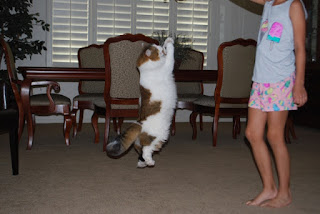Read this over and think about this. if the Below upsets, offends, concerns, worries or in any way causes you to hesitate - then by all means STOP. Do the cat a favor , do the breeder a favor do yourself a favor and run out immediately and get the one on the LEFT !
only stops long enough to grab your ankle and run
-yes this will involve a tiny drop of blood shed
purrs at your touch most likely will purr at your touch or your kids or your husbands or bite your hand or completely ignore you . What day of the week is it?
Shreds your new (insert object here ) couch chair jacket etc
Leaves fur on that business suit you left out the night before (or worse a fur ball !)
Decides today there is no way they will ever eat THAT food again. SO you go out and buy 12 different kinds of food hoping he wont starve
eats your childs hair ties – vet bill $2500 for surgery
gets a sniffle – you think he's dying – vet bill $300 nope not dying
gets lost for ½ a day you cant find him kids in tears you in panic – he comes nonchalantly out of the bathroom cabinet like “hey ..whats up ?”
you intend to permanently disfigure this animal by de-clawing it
you intend to abandon this animal when it gets old , pees on things or no longer amuses you.
you intend to neglect this animal by leaving it alone for long periods of time with no companionship or to feed it inappropriately or not seek regular veterinary care or yell or throw things at or in any other way intentionally injure this animal because you happen to be tired, sick, short tempered , or just plain ignorant of the animals innate behavior.
Shred the curtains
Scratch the furniture
Get claws stuck in the table cloth
and jump off in panic
breaking your
grandmothers good China
Eat the hamster
walk into the other room and meow
till you go into the room and pet them
Puke up hairballs on the rug,
carpet or bed
Spread “poo” all around when a
lovely little kernel gets
stuck in their tushy fur and they go
racing around the
house just sure they are being
pursued by a demon
Toss litter into every nook and
cranny you didnt even know existed , that is until you step on it.
purrs at your touch most likely will purr at your touch or your kids or your husbands or bite your hand or completely ignore you . What day of the week is it?
Shreds your new (insert object here ) couch chair jacket etc
Leaves fur on that business suit you left out the night before (or worse a fur ball !)
Decides today there is no way they will ever eat THAT food again. SO you go out and buy 12 different kinds of food hoping he wont starve
eats your childs hair ties – vet bill $2500 for surgery
gets a sniffle – you think he's dying – vet bill $300 nope not dying
gets lost for ½ a day you cant find him kids in tears you in panic – he comes nonchalantly out of the bathroom cabinet like “hey ..whats up ?”
you intend to permanently disfigure this animal by de-clawing it
you intend to abandon this animal when it gets old , pees on things or no longer amuses you.
you intend to neglect this animal by leaving it alone for long periods of time with no companionship or to feed it inappropriately or not seek regular veterinary care or yell or throw things at or in any other way intentionally injure this animal because you happen to be tired, sick, short tempered , or just plain ignorant of the animals innate behavior.


















































